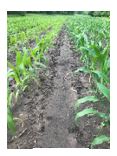The last several years have taught us that Mother Nature will always reign supreme. It’s time for us to evaluate what has transpired so far and determine if we need to alter any crop management decisions. Wet patterns will force a lot of growers to question how much nitrogen they possibly could have lost. With a lot of rain, we are bound to lose Nitrogen somewhere due to denitrification or just good ole fashion leaching. Below are a few key points to think about when assessing potential nitrogen loss.
1. ASSESS YIELD POTENTIAL
Yield potential needs to be assessed before any additional unplanned nitrogen application is made. Often experience can lead you to making the best decision when it comes to additional nitrogen needs. Corn that is completely dead in pond situations will need zero additional inputs, on the other hand it could look healthy with good color not yet showing the impacts of nitrogen deficiency. Key principle #4 below may help make the decision for an operation of the fence with high yield potential corn in the heavy rain belt. Figure 3, shows the difference that an additional 50 lb of nitrogen made in the crop response. The picture was taken in NW Missouri by an AgriGold agronomist not expecting to have loss.
Figure 3

Showing the difference that an additional 50 lb of nitrogen can make already in 2019
2. NITRATE SOURCE IS THE CONCERN
Nitrogen is susceptible to leaching and denitrification when it is in the nitrate form, not the ammonium form. Soil has a negative charge and will repel ions of like charges such as Nitrate (NO3- ) & Sulfur (SO42). Ammonium is a positively charged ion and will be held tightly to soil if it does not convert to Nitrate. Two things inhibit Ammonium conversion, soil temps below 50 degrees and an application of a nitrogen stabilizer. Remember which nitrogen forms that are already in a Nitrate solution before being applied, (Urea-100%, UAN-50%, NH3-0%, AMS-0%)
3. ESTIMATE LOSS FROM DENITRIFICATION AND LEACHING
Denitrification is triggered when soil organisms run out of oxygen from water-logged soils and will then utilize the oxygen found in Nitrates. Warmer temps dramatically increase denitrification rates. Nitrogen loss from leaching occurs when excess free water moves through the soil profile and carries free nitrate in solution with it. In the areas which have received 8+ inches of rain over the last 30 days, significant nitrate leaching, and denitrification has occurred. It is very difficult to estimate how much N-loss from leaching and denitrification occurred and sometimes we can still get high mineralization in high organic matter situations, but it is unpredictable. Advantage Acre’s nitrogen modeling tool (Figure 5) can help consolidate information and improve your decision-making.
Figure 4

Rainfall, topography, temperature, application timing, and nitrogen source are all used to calculate residual soil nitrogen and nitrogen needed to achieve your yield goal on a field by field basis
4.RAINFALL DATA = DECISION
The easiest and often the most accurate way to determine if you should apply additional nitrogen is simply based off rainfall totals April – June. Iowa State University has updated their data estimating the probability of receiving an economic response to additional nitrogen in-season due to excess spring rainfall. Their data show that if rainfall exceeds 15.5” from April 1-June 30th in western Iowa, there is a 76% probability that additional nitrogen will yield an economic response.
Just like the planting window, time may not be on your side for the rest of the growing season in a very wet year. Any additional nitrogen applications could be in a compressed window. It’s likely in a wet year that we have experienced a nitrogen loss of some amount. If conditions persist, N losses may get worse but using nitrogen modeling tools like Advantage Acre can provide some key insight for decision making. This nitrogen modeling tool in Advantage Acre helps answer how much you’ve potentially lost and what’s still needed to grow the crop. As shown in figure 4, rainfall, topography, temperature, application timing and nitrogen source are all used to calculate residual soil nitrogen and nitrogen needed to achieve your yield goal on a field by field basis. Please reach out to your local AgriGold Key Account Specialist or Agronomist to run some scenarios for yourself.
Sources:
Iowa State University Extension and Outreach. Integrated Crop Management. Sawyer, John. https://crops.extension.iastate.edu/cropnews/2018/06/potential-nitrogen-loss-2018
National Weather Service. https://water.weather.gov/precip/

